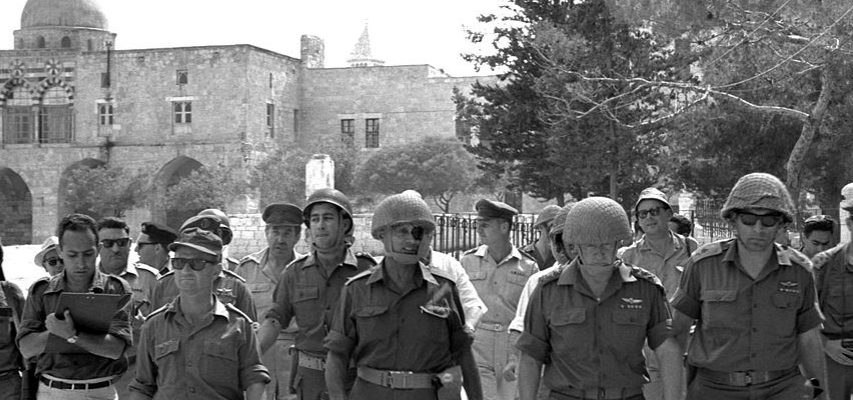Prior to Six Day War, Jewish residents of Jerusalem were routinely targeted by snipers and denied access to holy shrines. Yet since Jerusalem’s reunification, Jews from around the world come to pray at the Western Wall.
The Musrara neighborhood, located near the former ‘no-man-zone’ between Israel and Jordan prior to the Six Day War, suffered immensely before the reunification of the Holy City in the wake of Israel’s miraculous victory in 1967. Avi Elzam, a longtime resident of the neighborhood, recalls that it was very difficult to live in a divided Jerusalem.
“We used to have a very regular Shabbat schedule,” he recalls. “The morning would start with an encounter with the Arab Legion snipers. They shot at us out of sheer boredom.”
Ayala Sabbag, a former resident, says, “We didn’t have any shelter. Whenever they started to shoot, my mother would gather all her 11 children and carry the youngest ones up the street to the building of the Voice of Israel [radio station] where we would hide ourselves. The Voice of Israel’s building was in range of the shots, but at least they had a shelter inside.”
She continued, “The fire from the Jordanian soldiers was a part of our everyday life in Musrara. Their favorite time was on Shabbat mornings, I don’t know why, perhaps because we were all at home or in the yards down on Ayin-Het Street, so close to them. They managed to kill quite a few.”
In the days leading up to the Six Day War, the atmosphere was very tense in Jerusalem. According to Abraham Rabinovich, a reporter who arrived in Jerusalem five days before the Six Day War began, “2,000 volunteers turned out each day to dig trenches in areas where there were no shelters. Hundreds were yeshiva students. […] The woman who normally gave advice on etiquette on Israel Radio’s program for housewives treated the security crisis as sensibly as she handled other social complications. She advised mothers to let their school-age children play where they usually did and to explain to them that if the siren sounded, they should go to the nearest shelter where an ‘auntie’ would look after them. The listeners would, of course, be ‘aunties’ to any children that came into their shelters. Small children, she advised, had best be kept in sight.”
At first, Israel sought to avoid fighting on the Jordanian front and offered an olive branch to the Hashemite Kingdom to stay out of the war. The Jordanian king could not withstand the domestic pressure to join the war, in addition to the defense pact with Egypt, which made neutrality impossible. Within the Holy City, the situation was frightening for the residents, who lived in very close proximity to the Jordanian forces.

Yoske Schwartz was one of the brave Israeli soldiers who fought to defend Jewish Jerusalem and to reunite the Holy City. He recalls, “It was the night of June 5, and it was very, very dark. I remember the ambulances were blaring their sirens as they transported people to hospitals. We drove in total darkness, and I could only see my friends when something would explode outside. We had no idea where we were. Some of us had never even been to Jerusalem before.
“Suddenly the buses stopped, and our commander said to us ‘Put your helmets on, put your magazines in your guns and get yourselves ready, because in a few minutes you’ll be fighting.’ We started to laugh, and he didn’t understand why, and we said, ‘Commander, we learned how to fight in the Sinai desert, we don’t even know where we are right now.’ He said to us, ‘You’re in Jerusalem, on a street called Shmuel Hanavi, and as soon as we get to the corner of Shimon Hatzadik you’re going to get off the buses very quietly and start fighting.”
Schwartz was then sent to the Old City, where he was assigned the task of liberating the Western Wall. The fighting was fierce. According to Schwartz, “From where we were, we could see Ammunition Hill. We could see our people advancing every time a grenade exploded, and we could hear their shouts and screams, and then as quickly as they had left a flow of them came back, all of them on stretchers. The Jordanians fought to the death. We fought for many hours, and many died.”
In the end, Schwartz did manage to make it to the Western Wall, yet it came at an enormous humanitarian cost. Out of 1,200 paratroopers who fought for Jerusalem, only 400 lived; 183 Israeli soldiers perished while liberating Jerusalem, of whom 96 were paratroopers.
When Israel did reunite Jerusalem, the Jewish community was ecstatic. A dream that the Jewish people had kept for over 2,000 years was finally fulfilled. Jews across Israel flocked to the newly liberated Jerusalem to pray at the Western Wall, which had been denied to them during the Jordanian occupation of the Old City. Pnina Usherovitz was one of the many Jews who journeyed to Jerusalem in the wake of the Six Day War to visit the Western Wall.
“I have, thank G-d, been privileged many times since to get to the Kotel to pray. I have been there in the heat of mid-summer, in the cold of winter, in rain and in spring but I have never gone without remembering the first time. […] I lean my head on those cool, huge, ancient and rough stones that are smoothed over by the years and tears slide down my face and my soul relaxes. The tears are from gratitude that yes, once more I have been allowed to come close to the Kotel to rest and renew and hold on while I pray.”
By Rachel Avraham

